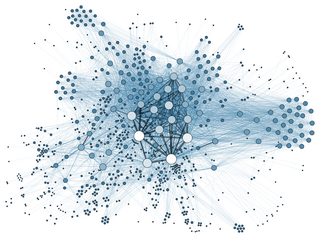
A subculture is a group of people within a cultural society that differentiates itself from the conservative and standard values to which it belongs, often maintaining some of its founding principles. Subcultures develop their own norms and values regarding cultural, political, and sexual matters. Subcultures are part of society while keeping their specific characteristics intact. Examples of subcultures include BDSM, hippies, hipsters, goths, steampunks, bikers, punks, skinheads, gopnik, hip-hoppers, metalheads, cosplayers, otaku, otherkin, furries, and more. The concept of subcultures was developed in sociology and cultural studies. Subcultures differ from countercultures.
The bandwagon effect is the tendency for people to adopt certain behaviors, styles, or attitudes simply because others are doing so. More specifically, it is a cognitive bias by which public opinion or behaviours can alter due to particular actions and beliefs rallying amongst the public. It is a psychological phenomenon whereby the rate of uptake of beliefs, ideas, fads and trends increases with respect to the proportion of others who have already done so. As more people come to believe in something, others also "hop on the bandwagon" regardless of the underlying evidence.

In sociology, popularity is how much a person, idea, place, item or other concept is either liked or accorded status by other people. Liking can be due to reciprocal liking, interpersonal attraction, and similar factors. Social status can be due to dominance, superiority, and similar factors. For example, a kind person may be considered likable and therefore more popular than another person, and a wealthy person may be considered superior and therefore more popular than another person.

A fad diet is a diet that is popular, generally only for a short time, similar to fads in fashion, without being a standard scientific dietary recommendation, and often making unreasonable claims for fast weight loss or health improvements; as such it is often considered a type of pseudoscientific diet. Fad diets are usually not supported by clinical research and their health recommendations are not peer-reviewed, thus they often make unsubstantiated statements about health and disease.
The expression collective behavior was first used by Franklin Henry Giddings and employed later by Robert Park and Ernest Burgess, Herbert Blumer, Ralph H. Turner and Lewis Killian, and Neil Smelser to refer to social processes and events which do not reflect existing social structure, but which emerge in a "spontaneous" way. Use of the term has been expanded to include reference to cells, social animals like birds and fish, and insects including ants. Collective behavior takes many forms but generally violates societal norms. Collective behavior can be tremendously destructive, as with riots or mob violence, silly, as with fads, or anywhere in between. Collective behavior is always driven by group dynamics, encouraging people to engage in acts they might consider unthinkable under typical social circumstances.
An information cascade or informational cascade is a phenomenon described in behavioral economics and network theory in which a number of people make the same decision in a sequential fashion. It is similar to, but distinct from herd behavior.
The trickle-down effect is a model of product adoption in marketing that affects many consumer goods and services.

Diffusion of innovations is a theory that seeks to explain how, why, and at what rate new ideas and technology spread. The theory was popularized by Everett Rogers in his book Diffusion of Innovations, first published in 1962. Rogers argues that diffusion is the process by which an innovation is communicated through certain channels over time among the participants in a social system. The origins of the diffusion of innovations theory are varied and span multiple disciplines.
Management fad is a term used to characterize a change in philosophy or operations implemented by a business or institution. It amounts to a fad in the management culture of an institution.
In social dynamics, critical mass is a sufficient number of adopters of a new idea, technology or innovation in a social system so that the rate of adoption becomes self-sustaining and creates further growth. The point at which critical mass is achieved is sometimes referred to as a threshold within the threshold model of statistical modeling.

Deviance or the sociology of deviance explores the actions and/or behaviors that violate social norms across formally enacted rules as well as informal violations of social norms. Although deviance may have a negative connotation, the violation of social norms is not always a negative action; positive deviation exists in some situations. Although a norm is violated, a behavior can still be classified as positive or acceptable.

The sociology of food is the study of food as it relates to the history, progression, and future development of society, encompassing its production, preparation, consumption, and distribution, its medical, ritual, spiritual, ethical and cultural applications, and related environmental and labor issues.
Behavioral contagion is a form of social contagion involving the spread of behavior through a group. It refers to the propensity for a person to copy a certain behavior of others who are either in the vicinity, or whom they have been exposed to. The term was originally used by Gustave Le Bon in his 1895 work The Crowd: A Study of the Popular Mind to explain undesirable aspects of behavior of people in crowds. In the digital age, behavioral contagion is also concerned with the spread of online behavior and information. A variety of behavioral contagion mechanisms were incorporated in models of collective human behavior.
Herd behavior is the behavior of individuals in a group acting collectively without centralized direction. Herd behavior occurs in animals in herds, packs, bird flocks, fish schools and so on, as well as in humans. Voting, demonstrations, riots, general strikes, sporting events, religious gatherings, everyday decision-making, judgement and opinion-forming, are all forms of human-based herd behavior.

Social contagion involves behaviour, emotions, or conditions spreading spontaneously through a group or network. The phenomenon has been discussed by social scientists since the late 19th century, although much work on the subject was based on unclear or even contradictory conceptions of what social contagion is, so exact definitions vary. Some scholars include the unplanned spread of ideas through a population as social contagion, though others prefer to class that as memetics. Generally social contagion is understood to be separate from the collective behaviour which results from a direct attempt to exert social influence.
Complex contagion is the phenomenon in social networks in which multiple sources of exposure to an innovation are required before an individual adopts the change of behavior. It differs from simple contagion in that unlike a disease, it may not be possible for the innovation to spread after only one incident of contact with an infected neighbor. The spread of complex contagion across a network of people may depend on many social and economic factors; for instance, how many of one's friends adopt the new idea as well as how many of them cannot influence the individual, as well as their own disposition in embracing change.

Planking is an activity consisting of lying in a face-down position, sometimes in an unusual or incongruous location. The palms of the hands are typically touching the sides of the body and the toes are typically touching the ground. Some players compete to find the most unusual and original location in which to play. The term planking refers to mimicking a wooden plank. Planking can include lying flat on a flat surface, or holding the body flat while it is supported in only some regions, with other parts of the body suspended. Many participants in planking have photographed the activity in unusual locations and have shared such pictures through social media.
Viral phenomena or viral sensation are objects or patterns that are able to replicate themselves or convert other objects into copies of themselves when these objects are exposed to them. Analogous to the way in which viruses propagate, the term viral pertains to a video, image, or written content spreading to numerous online users within a short time period. This concept has become a common way to describe how thoughts, information, and trends move into and through a human population.

Damon Centola is a sociologist and the Elihu Katz Professor of Communication, Sociology and Engineering at the University of Pennsylvania, where he is Director of the Network Dynamics Group and Senior Fellow at the Leonard Davis Institute of Health Economics.









